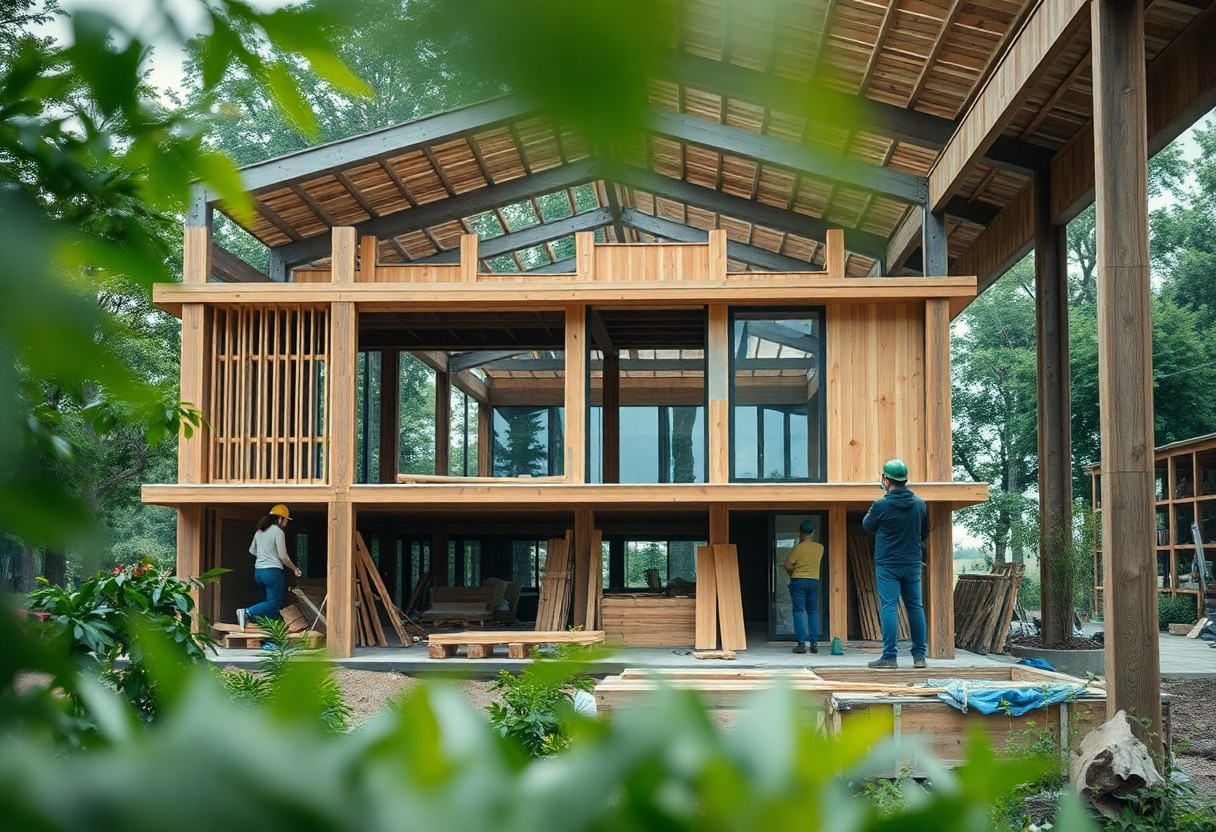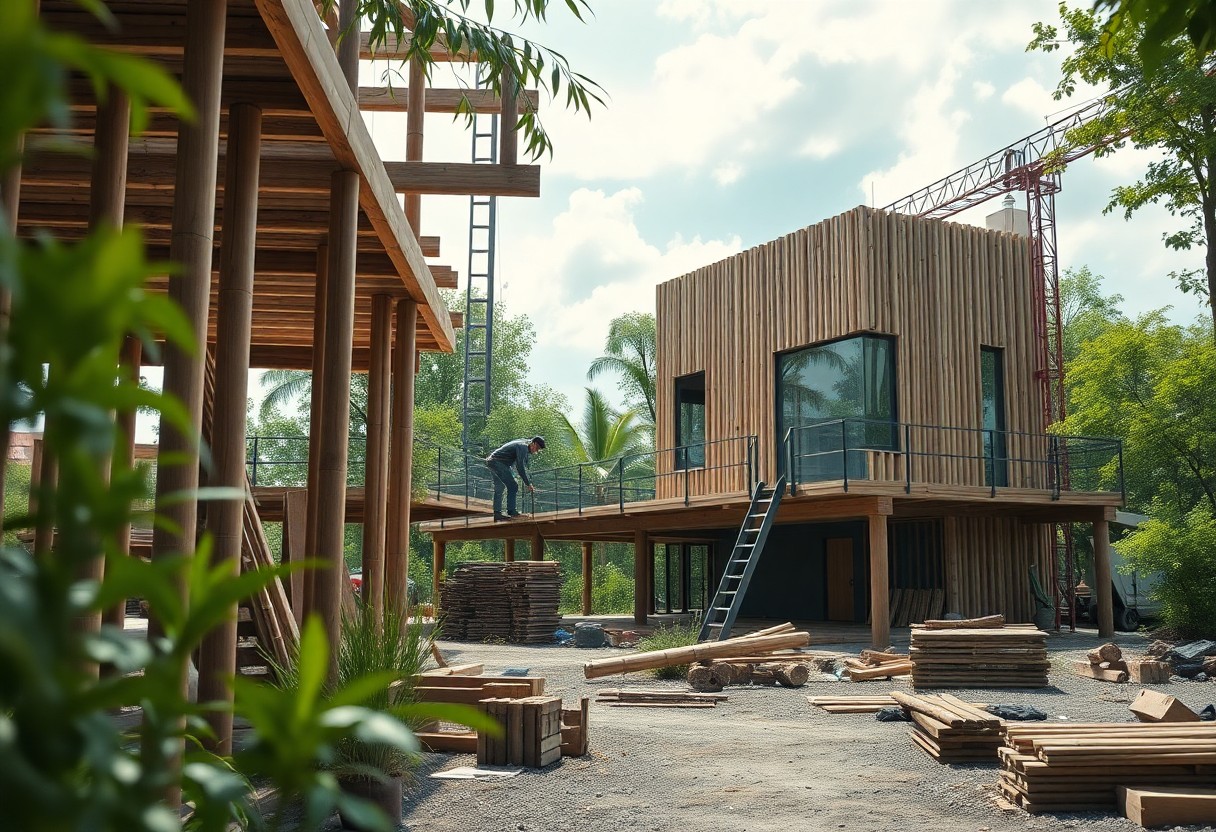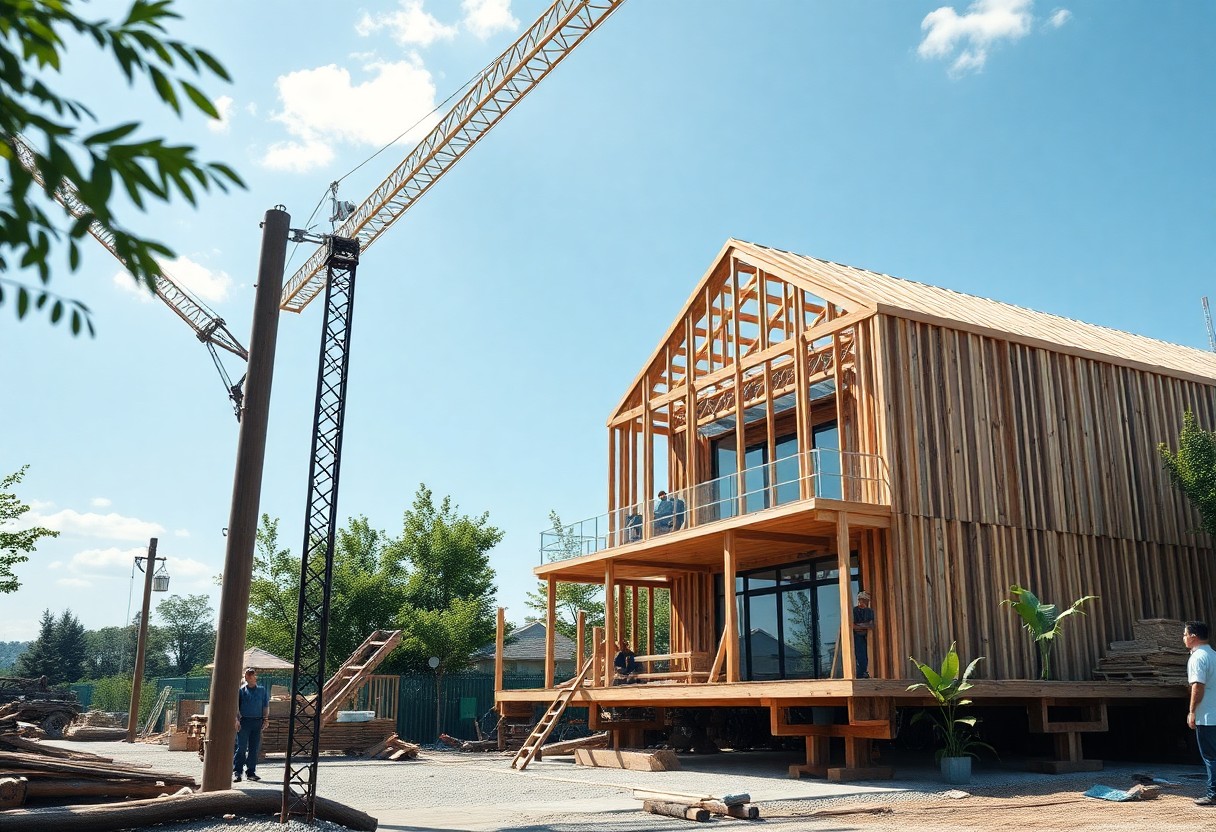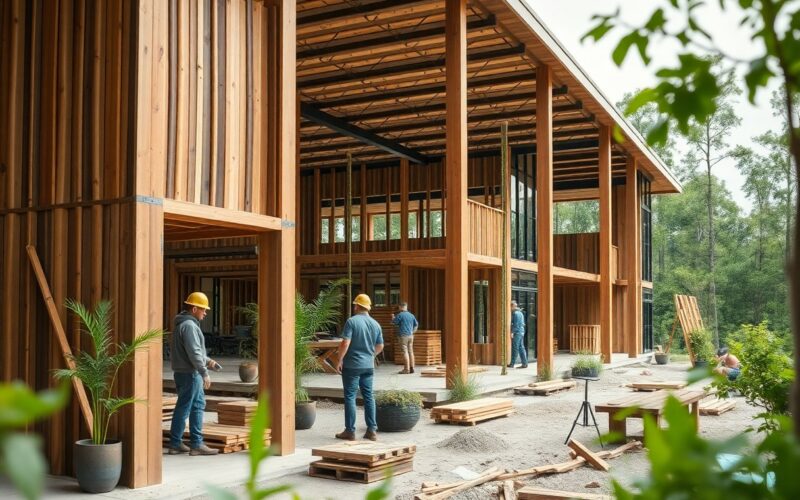Sustainable practices can dramatically enhance your construction projects by utilizing eco-friendly materials that minimize environmental impact. Incorporating these innovative materials not only helps you lower the carbon footprint of your buildings but also promotes long-term cost savings. You can explore 16 sustainable and cost-effective building materials that are revolutionizing the industry. By embracing these alternatives, you contribute to a healthier planet while ensuring your construction meets modern standards of efficiency and sustainability.
Table of Contents
Key Takeaways:
- Sustainable building materials, such as bamboo, recycled steel, and hempcrete, provide environmentally-friendly alternatives to traditional materials, reducing carbon footprints and promoting eco-friendly construction practices.
- Innovative products like mycelium-based materials and 3D-printed alternatives are emerging, showcasing advancements in technology that enhance the performance and sustainability of construction materials.
- Using reclaimed and repurposed materials not only minimizes waste in landfills but also adds unique character and history to new builds, appealing to eco-conscious consumers.
- Green certifications and standards, such as LEED and BREEAM, are driving the demand for sustainable materials as builders seek to achieve environmental recognition and meet regulatory requirements.
- Investing in sustainable materials can lead to long-term cost savings through reduced energy consumption, lower maintenance needs, and potential tax incentives for eco-friendly building projects.
The Importance of Sustainable Building Materials
Definition and Overview
The importance of sustainable building materials lies in their ability to minimize the impact of construction on the environment while supporting a more sustainable future. These materials are sourced, manufactured, and utilized in ways that prioritize environmental stewardship, social responsibility, and economic viability. As you consider your building projects, understanding what constitutes sustainable materials is crucial. They often incorporate elements such as renewable resources, non-toxic substances, and energy-efficient production processes.
With an increased focus on reducing carbon footprints and conserving natural resources, the adoption of sustainable building materials is becoming a defining trend in the construction industry. By making informed choices about the materials you use, you can not only enhance the quality of your construction but also contribute positively to the environment. By seeking out materials that are recycled, reclaimed, or sustainably harvested, your projects can embody principles of sustainability from the ground up.
Benefits to the Environment
Definition and overview of sustainable building materials highlight their multifaceted advantages, particularly in terms of environmental benefits. Sustainable materials can significantly reduce energy consumption and waste generation, leading to a smaller ecological footprint. By using resources that are renewable or have a minimal environmental impact, you help preserve biodiversity and reduce pollution associated with traditional building materials.
To take advantage of these benefits, implementing sustainable building practices can result in healthier living environments. For example, low-VOC (volatile organic compound) materials contribute to improved air quality, while natural insulation options help regulate temperature without excessive reliance on energy-intensive heating or cooling systems. Engaging in sustainable practices not only fulfills your environmental responsibilities but also positions your projects favorably in a market that increasingly values sustainability.
Economic Advantages
Materials that are sourced sustainably often lead to significant economic advantages in the long run. By investing in high-quality, durable materials, you can reduce maintenance costs and lower energy expenses. Sustainable buildings typically require less energy to operate, resulting in substantial savings over time. Moreover, properties built with these materials tend to have higher market value and appeal to eco-conscious buyers.
This economic edge extends to local economies as well. When you choose to work with local suppliers of sustainable materials, you can contribute to job creation and strengthen community ties. Reducing waste in construction also minimizes disposal costs, allowing your projects to operate more efficiently, which translates into time and cost savings. By prioritizing sustainable materials, you are investing in both your financial future and the well-being of your community.
Types of Sustainable Building Materials
It is imperative to understand the various types of sustainable building materials available in the construction industry today. With increasing awareness about environmental impact, these materials are transforming how you approach building and renovation projects. Here’s a breakdown of some prominent types:
| Recycled Materials | Using materials that have been salvaged or repurposed reduces waste and conserves natural resources. |
| Natural Materials | These materials are sourced from nature and are biodegradable, ensuring a minimal carbon footprint. |
| Innovative Modern Materials | These include advanced products developed to enhance sustainability, often involving cutting-edge technology. |
| Green Insulation Materials | Insulation made from sustainable resources such as sheep wool or cellulose contributes to energy efficiency. |
| Low-Impact Materials | Materials that minimize environmental disruption and are easy to source, like bamboo, fall under this category. |
Recycled Materials
Building with recycled materials is a smart choice for those looking to reduce their environmental footprint. Recyclable products such as reclaimed wood, recycled metal, and repurposed concrete not only lessen the impact on landfills but also often add unique character to your projects. Using recycled materials helps you create buildings that are both aesthetically pleasing and environmentally responsible.
Additionally, incorporating recycled materials often results in energy savings during production, further minimizing your project’s carbon emissions. By choosing materials like recycled glass or plastics, you support the efficient use of resources and contribute to a circular economy.
Natural Materials
With a growing emphasis on sustainability, the importance of natural materials in construction cannot be overstated. These materials, such as timber, stone, and clay, are not only renewable but also offer a range of benefits including durability and insulation properties. Opting for natural materials means you’re making a conscious choice to support the environment while ensuring a healthier living space.
Choosing natural materials in your construction projects helps in promoting energy efficiency and air quality. These materials typically require less energy to process and are often biodegradable, leading to fewer environmental pollutants over time. Their natural thermal properties can also enhance energy efficiency in your building.
Even when selecting materials for an eco-friendly project, you may find the aesthetic qualities of natural materials appealing. The warmth of wood, the texture of stone, and the versatility of clay all contribute to visually stunning environments that resonate with nature.
Innovative Modern Materials
Below are some innovative modern materials that are setting new standards in the construction industry. Innovations such as cross-laminated timber (CLT), which combines superior strength with sustainability, show how technology can create better building solutions. Other materials like translucent concrete and self-healing concrete also demonstrate impressive adaptability to meet the needs of modern architecture.
These innovative modern materials are not only designed for longevity but also possess the ability to improve the overall efficiency of structures. For instance, self-healing concrete contains bacteria that can heal cracks naturally, prolonging the material’s lifespan while reducing repair costs.
Consequently, engaging with innovative modern materials allows you to stay ahead of trends while ensuring that your buildings are environmentally friendly. Integrating these cutting-edge solutions can augment the sustainability efforts of your construction projects.
Thou should consider exploring more about these materials through resources like The 10 Best Sustainable Building Materials, where you can find valuable insights into how these materials are revolutionizing the industry.
Life Cycle Assessment in Construction
For anyone in the construction industry, understanding the full impact of building materials is imperative. Life Cycle Assessment (LCA) offers a comprehensive approach to evaluate the environmental effects of materials from their inception to disposal. By analyzing each phase—extraction, manufacturing, transportation, use, and disposal—you can make informed choices that promote sustainability. As you strive to keep up with the latest innovations, reading about The Future of Construction Materials: Trends to Watch in 2025 can provide valuable insights into sustainable options.
Understanding Life Cycle Assessment (LCA)
Around the world, LCA is becoming a standard practice in the construction sector, aiming to enhance sustainability by identifying areas for improvement. It not only evaluates carbon footprints but also considers energy consumption, material resources, and potential waste throughout a structure’s life span. By integrating LCA into your material selection process, you can develop a clearer picture of how your choices contribute to environmental degradation or conservation.
Additionally, LCA helps you compare different materials quantitatively, determining the best options for specific projects. This quantitative analysis can guide you towards genuinely sustainable materials while addressing the demands of building codes and regulations.
Evaluating Material Durability
Across the construction landscape, durability of building materials plays a vital role in the sustainability equation. Durable materials not only extend the lifespan of structures but also reduce the frequency of repairs and replacements, leading to lower overall resource consumption. When you assess materials, consider their resilience against environmental stressors such as weather, temperature fluctuations, and wear and tear, as this will influence how often you’ll need to modify or replace them over time.
And by prioritizing durable materials, you are making a positive investment in the future. Durable materials not only reduce waste but also minimize the need for new resources, contributing to a circular economy within the construction industry. For instance, utilizing materials that withstand harsh environmental conditions can significantly cut down replacement costs and required resources, highlighting the strong connection between durability and sustainability in construction practices.

Certifications and Standards
Now, understanding certifications and standards is vital for anyone involved in sustainable construction. These benchmarks not only guide you in choosing the right materials but also give you credibility in the market. They help you ensure that your building meets widely accepted environmental standards, thereby contributing to a healthier planet. Familiarizing yourself with these certifications can elevate your projects and enhance your reputation as a responsible builder.
Leadership in Energy and Environmental Design (LEED)
Environmental performance is at the forefront of the Leadership in Energy and Environmental Design (LEED) certification. Initiated by the U.S. Green Building Council, LEED provides a framework for assessing building sustainability through various aspects, including energy efficiency, water usage, and materials sourcing. By earning a LEED certification, you can demonstrate to your clients and stakeholders that your buildings not only reduce their carbon footprint but also utilize resources more efficiently. This recognition can lead to improved occupant satisfaction and an overall healthier living environment.
Additionally, achieving a LEED certification can significantly enhance your project’s marketability. Many individuals and organizations today prioritize sustainability in their purchasing decisions. As such, LEED-certified buildings often command higher rent and sale prices. You can position yourself as a leader in sustainable construction by investing not just in environmentally friendly materials but also in acquiring the credentials that validate your efforts.
Green Building Certification Institute (GBCI)
Above all, the Green Building Certification Institute (GBCI) plays a pivotal role in ensuring that building projects meet rigorous sustainability standards. GBCI administers the LEED certification as well as other related programs that focus on sustainable practices. Having GBCI accreditation can significantly enhance your design and construction credentials, providing you with a competitive edge. You’ll find that being part of an organization recognized for its commitment to sustainable building not only benefits your projects but also your professional growth.
To further exemplify its influence, GBCI has developed various certifications, including Zero Energy Building (ZEB) and Sustainable Sites Initiative (SITES). These specialized certifications help you set specific sustainability goals for your projects, making it easier for you to achieve excellence in design. As you explore into these offerings, you’ll discover numerous pathways to enhance your projects’ sustainability and impact.
International Sustainable Building Standards
Environmental awareness is reshaping the landscape of international construction through International Sustainable Building Standards. These standards are designed to unify global practices in sustainability and improve overall building performance. They allow you to analyze energy consumption, material use, and indoor environmental quality, promoting a comprehensive approach to sustainable building that transcends geographical borders. Embracing these international standards can help you benchmark against global best practices, ensuring your projects meet the highest quality and sustainability levels.
Plus, adopting these international standards prepares you to compete in a global market increasingly focused on environmental stewardship. As sustainable architecture continues to rise in importance, being knowledgeable about international standards not only enhances your projects but also broadens your potential client base. By including these standards in your workflow, you can assert yourself as a frontrunner in the sustainable building movement, opening doors to new opportunities and partnerships.

Case Studies of Sustainable Buildings
Once again, you will see how sustainable building materials are influencing the construction industry through various real-world examples. The following case studies illustrate innovative projects that are both environmentally responsible and economically efficient:
- The Edge, Amsterdam – Known for its exceptional energy efficiency, this office building boasts a 98% sustainability score. It utilizes a solar array and rainwater harvesting systems.
- One Central Park, Sydney – Incorporating vertical gardens, this residential complex reduces heat while improving air quality, achieving a five-star Green Star rating.
- Bullitt Center, Seattle – Often termed the “greenest commercial building in the world,” it employs composting toilets and generates 100% of its energy on-site through solar panels.
- Bosco Verticale, Milan – Featuring over 9,000 trees, this project improves biodiversity while providing residents with natural insulation and reduced energy costs.
- EcoARK, Taipei – Built from recycled PET bottles, this structure highlights the innovative use of recycled materials and has a net-zero energy footprint.
Residential Projects
Projects focusing on sustainable materials for residential buildings have emerged as a significant trend within your community and beyond. Take, for example, the Green Build homes in California, which use renewable materials like bamboo, reclaimed wood, and high-performance insulation. These homes consume 30% less energy than traditional homes and offer excellent indoor air quality, ensuring your family’s health and comfort.
Additionally, the Zero Energy Home in Oregon exemplifies the fusion of cutting-edge technology and sustainability. These homes utilize solar panels and energy-efficient appliances, allowing homeowners to produce as much energy as they consume annually. This not only reduces utility costs but also contributes significantly to a lower carbon footprint.
Commercial Projects
Sustainable construction in commercial projects continues to gain traction as businesses recognize the benefits of green buildings. One prominent example is the Salesforce Tower in San Francisco, which is LEED Platinum certified. Not only does this skyscraper utilize reclaimed water and energy-efficient systems, but it also includes green terraces that enhance urban biodiversity, making it a model for sustainable urban living.
Furthermore, the Microsoft Campus in Redmond has achieved a net-zero carbon footprint through the use of cutting-edge sustainable technologies, such as advanced heating and cooling systems that are powered by renewable sources.
Also, focusing on sustainable materials and practices in commercial projects can increase your building’s value and attractiveness to tenants. Many companies are now prioritizing office spaces that reflect environmental responsibility, reflecting a growing trend where both employees and consumers are more inclined to engage with businesses committed to sustainability.
Government Initiatives
Above all, your government plays a vital role in promoting sustainable building initiatives through regulations and incentives. Programs like the Energy Star for buildings encourage property owners to make energy-efficient upgrades and constructions. By adopting mandatory building codes that require the use of green materials, local governments are helping to lead the way in constructing more sustainable urban environments.
Moreover, federal initiatives such as the LEED Certification support sustainable practices across various sectors, providing a framework that encourages construction projects to adopt eco-friendly materials and processes.
Buildings that adhere to these government initiatives are often eligible for tax breaks and grants, making it easier for you to invest in sustainable practices. As these policies evolve, they contribute significantly to a shift towards a more sustainable built environment, ultimately benefiting everyone involved.
Challenges and Limitations
Your journey into sustainable building materials may reveal a myriad of benefits, but it is necessary to also recognize the challenges that you might encounter along the way. Addressing these challenges head-on can empower you to make informed decisions and effectively navigate the changing landscape of construction.
Cost Barriers
Challenges related to cost barriers often surface when considering the adoption of sustainable building materials. While initial expenses may be higher for eco-friendly options, you should weigh these costs against the long-term savings associated with energy efficiency, reduced maintenance, and the potential for increased property value. Even so, these upfront costs can deter many builders and homeowners from making the switch, especially in budget-sensitive projects.
Additionally, varying costs can arise from insufficient supply chains, leading to price volatility in the market. As you explore sustainable alternatives, it’s important to factor in your own financial constraints and assess what trade-offs are acceptable to you, as these barriers can significantly impact your project’s viability.
Availability of Materials
Among the challenges tied to sustainable building materials is the availability of materials. While some innovative products are emerging in the market, you may find that not all local suppliers carry eco-friendly options, which can restrict your choices and complicate your sourcing process. Dependence on specific regions for sustainable materials can also lead to logistical issues that could delay project timelines.
The rise of demand for sustainable building materials does not always guarantee a consistent supply. As more builders embrace green options, the market must adapt to this shift, which can take time. To successfully address availability challenges, engage in thorough research, network with suppliers, and consider partnering with manufacturers who prioritize sustainability.
Building Codes and Regulations
An additional factor you might encounter is the complexity of building codes and regulations. Many jurisdictions possess strict guidelines concerning construction materials, which can sometimes impede the incorporation of sustainable options. As you launch on your project, it’s vital to familiarize yourself with local regulations to ensure compliance and avoid potential setbacks during the approval process.
It is worth noting that while some building codes are starting to evolve in response to the growing focus on sustainability, many still reflect conventional construction practices that can inadvertently restrict innovation. Engaging with local governments and advocating for updated codes can be a proactive way to contribute to the future of sustainable building.

Future Trends in Sustainable Building Materials
Not only is the construction industry evolving, but the demand for sustainable building materials is shaping a future where environmentally friendly practices become the norm. As you navigate the landscape of modern construction, it’s important to stay informed about emerging materials that promote sustainability while delivering high performance and cost-effectiveness.
Biodegradable Materials
To embrace a more ecological approach to construction, many professionals are now turning to biodegradable materials. These materials, which can break down naturally at the end of their life cycle, help reduce landfill waste and minimize the environmental impact of your building projects. Examples include mycelium-based bricks and those made from agricultural byproducts, which not only provide structural stability but also integrate seamlessly back into nature.
To capitalize on biodegradable materials, you can incorporate them into your designs without sacrificing aesthetics or durability. Many of these innovative products are designed to mimic traditional building materials, offering both functionality and visual appeal. As you consider your next project, think about how utilizing biodegradable materials can reflect your commitment to sustainability while attracting environmentally-conscious clients.
Smart Materials
About the future of construction, smart materials represent a significant shift toward sustainability and efficiency. These materials have the ability to respond dynamically to environmental changes, optimizing energy use and enhancing the comfort of the inhabitants within a building. For your projects, incorporating smart materials, like photochromic glass or self-healing concrete, can lead to more efficient buildings that are easier on the planet.
Materials like shape-memory alloys and thermochromic pigments can adapt to varying conditions, contributing to energy conservation and improved air quality. By integrating these advanced technologies, you can create spaces that not only perform better but also resonate with modern demands for sustainability. Smart materials enable a transformative approach to building design by harmonizing human needs with ecological responsibility.
The Role of Technology in Sustainability
The intersection of technology and sustainable building materials is fostering innovation that you might find crucial to your projects. Advanced manufacturing techniques, such as 3D printing and modular construction, allow for the efficient use of materials, reducing waste, and enabling the rapid assembly of structures. By embracing these technologies, you can achieve higher precision in your builds, further minimizing the environmental impact.
For instance, the use of Building Information Modeling (BIM) enables you to visualize and optimize your construction plans before materials are ever put to use. This not only enhances your project management capabilities but also reinforces sustainability goals by ensuring that every resource is accounted for and used effectively. As technology continues to evolve, staying updated on these practices will be crucial to your success in sustainable construction.
Final Words
From above, it is clear that sustainable building materials are playing a transformative role in the construction industry. As you explore the various options available, you will find that incorporating these materials into your projects not only benefits the environment but also enhances the efficiency and longevity of your buildings. By shifting toward eco-friendly materials such as bamboo, recycled steel, and insulation made from sheep’s wool, you can significantly reduce your carbon footprint while promoting healthier indoor environments. This commitment to sustainability can also resonate positively with clients and stakeholders who increasingly value green building practices.
As you initiate on your journey into sustainable construction, take the time to research and invest in innovative materials that align with your vision and project goals. Your choice can lead the way toward a more sustainable future, fostering a positive impact on the community and the planet. By embracing these advancements, you position yourself at the forefront of an evolving industry, equipped with the knowledge and resources to design buildings that are not only functional and beautiful but also responsible and sustainable.
FAQ
Q: What are sustainable building materials?
A: Sustainable building materials are resources used in construction that have a minimal negative impact on the environment. They can be sourced responsibly, are often renewable, and typically have a lower carbon footprint compared to traditional materials. Examples include bamboo, recycled steel, and reclaimed wood.
Q: How do sustainable building materials benefit the construction industry?
A: The adoption of sustainable building materials promotes environmental conservation, reduces waste, and leads to improved energy efficiency. These materials often require less energy to produce and contribute to healthier indoor environments. As a result, they can also enhance the overall value and marketability of a property.
Q: What is the role of recycled materials in sustainable construction?
A: Recycled materials play a significant role in sustainable construction by diverting waste from landfills and reducing the demand for new resources. Commonly recycled materials in construction include concrete, metals, and glass. Utilizing these materials minimizes environmental degradation and conserves natural resources.
Q: How do sustainable buildings impact energy efficiency?
A: Sustainable buildings are designed to optimize energy efficiency through the use of advanced materials that provide better insulation and thermal performance. This leads to reduced energy consumption for heating and cooling, ultimately resulting in lower utility bills and a smaller carbon footprint over the building’s lifespan.
Q: What certifications exist for sustainable building materials?
A: Several certifications help identify truly sustainable building materials. Notable examples include LEED (Leadership in Energy and Environmental Design), FSC (Forest Stewardship Council) for wood products, and the Cradle to Cradle certification that evaluates the lifecycle of materials. These certifications ensure goods align with environmentally responsible practices.
Q: Are sustainable materials more expensive than conventional materials?
A: While the initial cost of some sustainable materials may be higher, long-term savings often offset this investment. Reduced energy costs, lower maintenance, and increased property value contribute to the overall financial viability of utilizing these materials in construction projects.
Q: What trends in sustainable building materials are emerging in the construction industry?
A: Emerging trends include the use of biobased materials, such as mycelium and hempcrete, which are gaining traction for their low environmental impact. Additionally, innovations in cross-laminated timber and 3D printing using sustainable feeds are revolutionizing how structures are built. The focus is increasingly on circular economy principles, where materials are reused or recycled at the end of their life cycle.

Our contributing author is a passionate advocate for eco-friendly living and sustainability. With a background in eco-life, they are dedicated to inspiring and empowering individuals to adopt environmentally conscious lifestyles. Through insightful articles, they share practical tips, innovative solutions, and thought-provoking perspectives to promote a greener, more sustainable world. Join them on the journey towards eco-smart living and discover how small choices can make a big impact. 🌱









